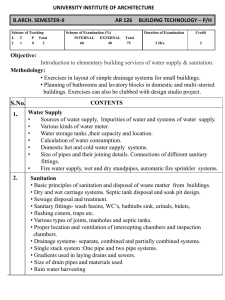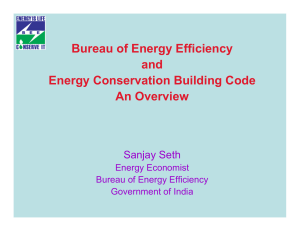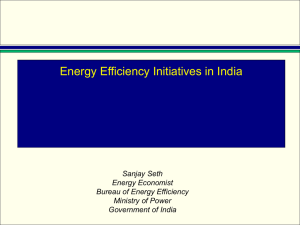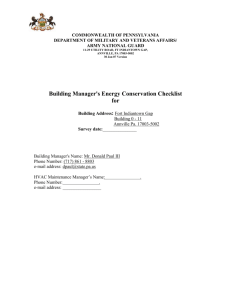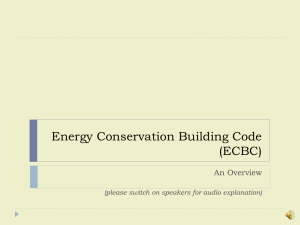An Introduction to ECBC
advertisement
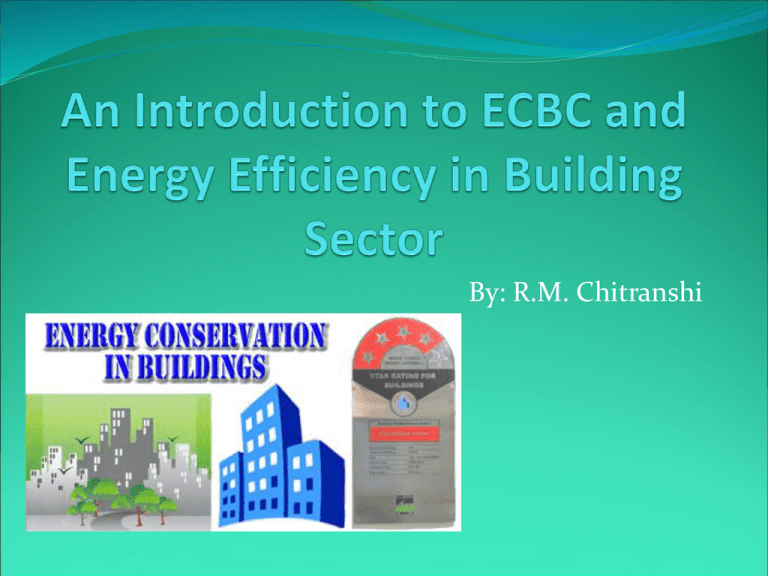
By: R.M. Chitranshi ECBC With the background of high energy saving potential and its benefits bridging the gap between demand and supply, reducing environmental emissions through energy saving and to effectively over come the barrier the Govt. of India has enacted the Energy Conservation Act, 2001. The Act provides the much needed legal framework and institutional arrangement for embarking on an energy efficiency drive. This includes Energy Conservation Building Code. The Act empowers Govt. of India and State Governments to modify ECBC as per climatic conditions of states. And to notify the code in Govt. gazette to make it mandatory for commercial buildings having a connected load of 500 kW or maximum demand of 600 kVA or above or 1000 sq. m of air conditioned area. Purpose The purpose of this code is to provide minimum requirements for energyefficient design and construction of buildings. Scope Minimum energy performance standards for design and construction be prescribed. Applies to new construction and major renovation. Building components included Building Envelope (Walls, Roofs, Windows) Lighting HVAC system Service water heating and pumping Electrical Systems (Power factor, Tramsformer) Impact of ECBC – Energy Savings Average energy use: For light and HVAC a typical class A office building consumes 200kWh/sq m/Yr. Mandatory enforcement of ECBC is likely to reduce the energy use by 30-40% to 120 – 160 200kWh/sq m/Yr. Energy saving as per BEE estimate – Saving of 1.7 billion kWh, with national mandatory enforcement, in the first year it self. Impact of ECBC Compliance Market Development for EE products. Building Insulation Energy Efficient Windows High efficiency HVAC systems Improved Design Practices. Lighting and Day Lighting Natural Ventilation/ Free cooling system Improved Building performance. Lower HVAC load. Lesser addition of power generation capacity. Implementation Plan Awareness and technical resources Quick implementation guide. Compliance resources. Building Envelop A well designed building envelop not only help in complying with ECBC code but can also result in first cost saving by taking advantage of day light and correct HVAC system sizing. Definition of Commercial Building According to energy information administration- Any building that is used for neither residential, manufacturing, nor agricultural purposes. Many types of commercial buildings Office Buildings Hotels Restaurants Retail malls and shops Hospitals Educational Institutes. Importance of Energy Efficient Envelope Design Helps in reducing heating/ cooling load. Helps in optimizing daylight. First cost and recurring savings. Helps in utilizing latest technological advances Simulation models greatly helps in designing high performance envelops. Energy Efficiency in Existing Buildings/ facilities There is vast scope for energy efficiency improvement in buildings/existing facilities. Energy Audit Studies have revealed a savings potential to the extent of 40% in end use such as lighting, cooling, ventilation, refrigerationetc. Audits identify the Energy baselines in existing facilities along with Energy Efficiency Measures. Energy Efficiency Measures Energy efficiency measures bring about energy savings due to reduced energy consumptions. Energy savings are determined by comparing energy baseline with energy consumed after implementation of EE measures. Energy cost savings resulting from EE measures directly benefit building owners and occupants over the life cycle of the building. Barriers to Energy Efficiency Lack of information about comparative energy use. Risk due to lack of confidence in performance of new technologies. Higher cost of EE technologies. Asymmetry in sharing of costs and benefits.-especially in building sector. Case Study (I) - Energy Audit of Bapu Bhawan Secretariat ECO’s Energy Savings (Rs Lacs) Estimated Investments (Rs Lacs) Simple Payback Period (Months) Short Term Measures (with Payback Period upto 1 year) Reactive Power Compensation and Power Factor Improvement (9286 Kvah) De-energization of Transformers 5.56 5.0 10-11 0.47 Nil Immediate Periodic Maintenance of AHU’s 1.12 Nominal Immediate Maintenance of the Chillers 3.52 2.0 6-7 Use of FRP Blades on the CT Fans 1.0 0.80 9-10 Replacement of High Efficiency Chilled and Condenser Water pumps 6.16 6.0 11-12 Sub Total (A) 17.83 13.80 9-10 Long Term Measures (with Payback Period above 1 year) Controlling the Demand within Specified Limits Installation of Energy Efficient Lights 0.11 0.35 38-39 22.31 28.6 15-16 Sub Total (B) 22.42 28.95 15-16 Total (A+B) 40.25 42.75 12-13 Case Study (II) - Energy Audit of Shastri Bhawan Secretariat ECO’s Energy Savings Kwh/annum Rs Lacs Estimated Investments (Rs Lacs) Simple Payback Period (Months) Short Term Measures with Payback Period upto 1 year De-energization of Transformers 37431 1.87 Nil Immediate Optimization of Lighting Voltage 67950 3.39 Nil Immediate Periodic Maintenance of AHU’s 4639 0.23 Nominal Immediate Replacement of Condenser Water Pumps (2 nos) with one New Pump Sub Total (A) 30268 1.51 0.40 3-4 140288 7.00 0.40 < 1 month Long Term Measures with Payback Period above 1 year Installation of Energy Efficient Lights 157526 7.87 11.19 17-18 Use of FRP Blades on the CT Fans 3888 0.19 0.20 12-13 Replacement of Inefficient A/Cs with Star Rated A/Cs Installation of Solar Water Heating System for the Canteen Sub Total (B) 54432 2.72 6.6 29-30 2100 0.11 0.40 43-44 217946 10.89 18.39 20-21 Total (A+B) 358234 17.89 18.79 12-13 Helpful Tips to Architects and Developers Select an organization/ consultant with expertise and experience in performing building energy simulation. Always inquire for key input parameters and output reports (e.g. thermal specifications of wall, glazing, and roof elements, load and system summary reports. Ask simulation consultant to perform parametric studies to evaluate: Relative cost and benefits of selecting key components and technologies (glazing, lighting) Sizing of HVAC system.



